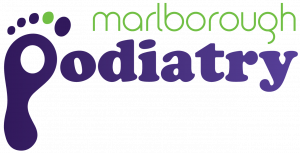Knee Pain In Kids: What You Need To Know!
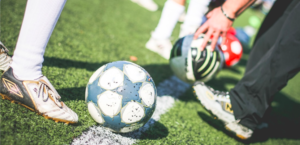
If you’ve ever seen your child limp off the field, in pain, clutching their knee, and unable to participate in the activities that they love and wake up very early in the morning for, then you’ll know how devastating it feels. Many of these kids and parents go on to be advised that they’re just experiencing growing pains, and that little can be done aside from waiting it out, without offering any further explanation.
As Podiatrists that specialise in caring for growing feet and legs here at Marlborough Podiatry, we can confidently tell you that pain in the knees does not occur without a definite cause. When you know the cause, there are various things that can be done to help resolve the pain and speed up their recovery – and get those smiles back on their faces!
So, what exactly is going on for these kids? If your child is aged between 8 – 15 years and is suffering from knee pain during sport, there’s a good chance that they could have Osgood-Schlatter’s Disease.
What is Osgood-Schlatter’s Disease?
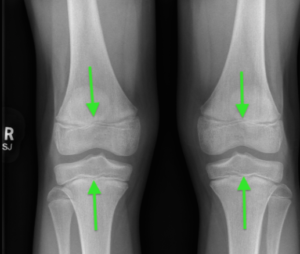 Don’t worry! Despite its name, Osgood-Schlatter’s is not an actual disease, but a condition that affects growing children temporarily, often referred to as an overuse injury. It’s medically known as tibial tuberosity apophysitis and describes the inflammation, and subsequent pain, just below the kneecap. Osgood-Schlatters has been shown to affect both knees in 50% of those affected.
Don’t worry! Despite its name, Osgood-Schlatter’s is not an actual disease, but a condition that affects growing children temporarily, often referred to as an overuse injury. It’s medically known as tibial tuberosity apophysitis and describes the inflammation, and subsequent pain, just below the kneecap. Osgood-Schlatters has been shown to affect both knees in 50% of those affected.
The exact location of the pain is at the growth plate near the top of the tibia (shin bone), at a bony prominence called the tuberosity. If you feel a couple of inches below your kneecap, you should be able to feel this bump. Generally, growth plates are vulnerable, cartilaginous areas located towards the ends of growing bones, where new bone is added, and will eventually turn into solid bone when we reach full maturity.
We’ve illustrated the growth plates on both the femur (top) and tibia (bottom) on the x-ray below. The space between the bones is the knee joint, and the lines within the bones that may appear as breaks are actually the growth plates.
What causes Osgood-Schlatter’s Disease?
To explain simply, it’s caused by the strong pull of the quadriceps muscles at the front of our thighs where it attaches to the area of the tuberosity and growth plate. The quads cross the knee as the patellar tendon which attaches to the tibia, so any tight pull from the quads creates a tight pull on the tendon and its attachment site too. It’s this repetitive tight pull that causes pain, tenderness and swelling. This is why the pain often occurs during sport where the quads are used repetitively and strenuously, such as any running and kicking sports such as soccer, basketball, football, and many others.
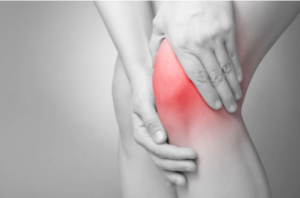 As we grow, our bones, muscles and tissues all grow and lengthen too – though growth may not occur at the same rate during a
As we grow, our bones, muscles and tissues all grow and lengthen too – though growth may not occur at the same rate during a
growth spurt. This is often another case of Osgood-Schlatters when the rate of growth of the femur (upper leg bone) exceeds the rate of growth of the quadriceps during growth. This will pull on the patellar tendon at its attachment at shin bone and cause pain. This can occur at any time that the quads are used, such as in walking, but will also be exacerbated during sport. Tight calf muscles will also produce a similar result. Because this happens during growth and is exacerbated by sports, it is active, growing kids aged between 8 – 15 years that are most commonly affected.
What are the symptoms?
- Pain, swelling and tenderness is present just below the kneecap at the bony bump
- Pain is present on palpation of the tuberosity and growth plate
- Pain is exacerbated by physical activity, especially when bending the knee and kneeling
If the pain is extreme, an avulsion fracture may have occurred. Your Podiatrist will best help determine if this is a possibility and send you for appropriate imaging studies where required, such as an x-ray.
How long does the pain last?
Each case is different and while mild symptoms may resolve after a few days, severe symptoms can last for years. Rest assured, you don’t just have to ‘wait it out’ and there are things that can be done to reduce and help alleviate the painful symptoms.
How is Osgood-Schlatter’s treated?
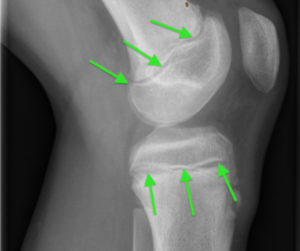 Following ruling out other causes of knee pain and an accurate diagnosis of Osgood- Schlatters, a customised treatment plan is created by our expert Podiatrists here at Marlborough Podiatry. While initially the first step will be alleviating the current pain through icing, anti-inflammatories and modifying activity, the goal of the treatment plan will be to reduce the strain from the quadriceps/patellar tendon at its attachment on the shin bone so that the pull isn’t enough to cause pain in the first place.
Following ruling out other causes of knee pain and an accurate diagnosis of Osgood- Schlatters, a customised treatment plan is created by our expert Podiatrists here at Marlborough Podiatry. While initially the first step will be alleviating the current pain through icing, anti-inflammatories and modifying activity, the goal of the treatment plan will be to reduce the strain from the quadriceps/patellar tendon at its attachment on the shin bone so that the pull isn’t enough to cause pain in the first place.
The treatment plan we prescribe is completely tailored to your child’s symptoms and the results of their comprehensive biomechanical examination. This helps us identify the often multiple causes of the pulling force, and hence the best way to help alleviate their painful symptoms. Despite the pain being located just below the knees, even the position and alignment of the feet can have a significant impact on the severity of the symptoms.
At Marlborough Podiatry, we have a special focus on isometric strengthening and stretching the quadriceps muscles without putting much stress on the patellar tendon and the patella itself. We’ve found this to have fantastic outcomes for our patients and sees them feeling great in a much shorter timeframe. Additionally, we’ve found orthotics to also be a great adjunct to treatment through correcting any identified malalignment in the feet, legs, knees and even hips.
Marlborough Podiatry, Kids & Knee Pain
We’re proud to be experts in caring for the feet and legs of active, growing kids. We’re parents too so know how distressing it is to see your kids in pain and not knowing how to help. Being able to see our patients out of pain and back to living life to their fullest is at the heart of what we do.
We promise to deliver consistent, quality healthcare that aims to get you feeling better, moving better and gets you that step closer to realising your own goals to success! We love seeing our patients create their own great success stories and knowing that we’ve played a crucial role in that.
To find out more or to book an appointment, give our friendly team a call on 03 972 2927 or email us on kaylene@marlboroughpodiatry.nz
References
1. de Lucena, G., dos Santos Gomes, C., & Guerra, R. (2011). Prevalence and associated factors of Osgood-Schlatter syndrome in a population-based sample of Brazilian adolescents. American Journal of Sports Medicine, 39(2). doi: 10.1177/0363546510383835
2. O’Keefe, S., Hogan, B., Eustace, S., & Kavanagh, E. (2009). Overuse Injuries of the knee. Magnetic resonance Imaging Clinics of North America, 17(4), pp.725-739.
3. Rio, E., Kidgell, D., Mosely, L., Cook, J. (2013). Exercise to reduce tendon pain: A comparison of isometric and isotonic muscle contractions and effects on pain, cortical inhibition and muscle strength. Asics Conference 2013. Journal of Science and Medicine in Sport. DOI: 10.1016/j.jsams.2013.10.067
4. Rio, E., Kidgell, D., Purdam, C., Gaida, J., Moseley, L., Pearce, A., & Cook, J. (2015). Isometric exercise induces analgesia and reduces inhibition in patellar tendinopathy. British Journal of Sports Medicine, 49, 1277-1283. doi:10.1136/bjsports-2014-094386
5. Whitmore, A. (2013). Osgood-Schlatter disease. Journal of the American Academy of Physician Assistants, 26(10). doi: 10.1097/01.JAA.0000435006.47717.41
